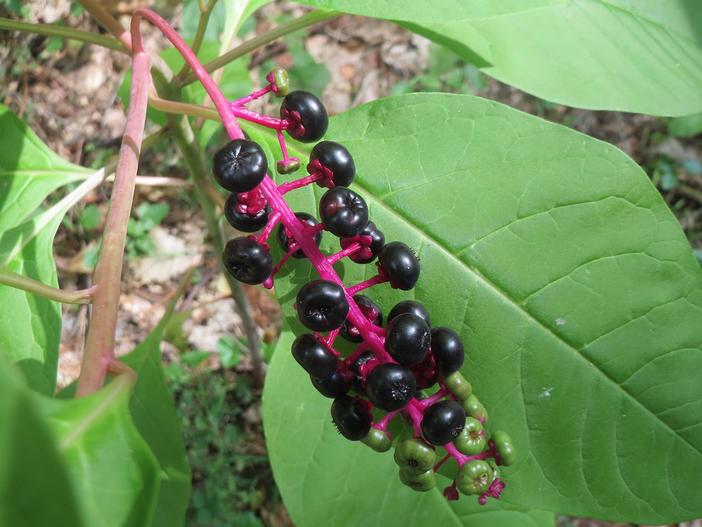American Pokeweed
(Phytolacca americana)
American Pokeweed (Phytolacca americana)
/
/

Andreas Rockstein
CC BY-SA 2.0
Image By:
Andreas Rockstein
Recorded By:
Copyright:
CC BY-SA 2.0
Copyright Notice:
Photo by: Andreas Rockstein | License Type: CC BY-SA 2.0 | License URL: https://creativecommons.org/licenses/by-sa/2.0/ | Uploader: anro0002 | Publisher: Flickr














































































Estimated Native Range
Summary
Phytolacca americana, commonly known as American Pokeweed, is a deciduous perennial herb native to a variety of habitats including open woodlands, forest edges, and fields across the Eastern and Central USA. It can grow between 4 to 10 feet (1.2 to 3.0 m) tall and is known for its large, alternate leaves on green to red or purplish stems and a significant white taproot. The plant produces small, green to white flowers in elongated clusters during the summer, which are moderately showy and attract pollinators. These flowers give way to berries that progress in color from green to red and eventually to a deep purple or almost black as they mature. The berries are a valuable food source for birds and small animals, although they are toxic to humans.
American Pokeweed is often grown for its striking berries and bold foliage, which can add visual interest to garden borders and wildflower gardens. It is relatively easy to maintain, but gardeners should be cautious as all parts of the plant are toxic if ingested. It prefers full sun to part shade and is adaptable to a range of soil types, from well-drained to moist conditions. While some cultivars have been developed for larger fruit panicles, the species itself can become weedy and spread aggressively if not managed. It is potentially invasive outside its native range, including in California, and gardeners should consult local guidelines before planting.CC BY-SA 4.0
American Pokeweed is often grown for its striking berries and bold foliage, which can add visual interest to garden borders and wildflower gardens. It is relatively easy to maintain, but gardeners should be cautious as all parts of the plant are toxic if ingested. It prefers full sun to part shade and is adaptable to a range of soil types, from well-drained to moist conditions. While some cultivars have been developed for larger fruit panicles, the species itself can become weedy and spread aggressively if not managed. It is potentially invasive outside its native range, including in California, and gardeners should consult local guidelines before planting.CC BY-SA 4.0
Plant Description
- Plant Type: Herb
- Height: 6-10 feet
- Width: 3-5 feet
- Growth Rate: Rapid
- Flower Color: White
- Flowering Season: Summer
- Leaf Retention: Deciduous
Growth Requirements
- Sun: Full Sun, Part Shade
- Water: Medium
- Drainage: Fast, Medium, Slow
Common Uses
Bee Garden, Bird Garden, Butterfly Garden, Deer Resistant, Drought Tolerant, Edible*Disclaimer: Easyscape's listed plant edibility is for informational use. Always verify the safety and proper identification of any plant before consumption., Rabbit Resistant
Natural Habitat
Native to a variety of habitats including open woodlands, forest edges, and fields
Other Names
Common Names: Common Pokeweed , Inkberry , Pigeonberry , Poke , Pokeberry , Pokeweed , Pokeroot , Virginia Poke , Kermesbeere , Amerikanische Kermesbeere
Scientific Names: Phytolacca americana , Phytolacca decandra , Phytolacca americana var. lancifolia , Phytolacca vulgaris
GBIF Accepted Name: Phytolacca americana L.